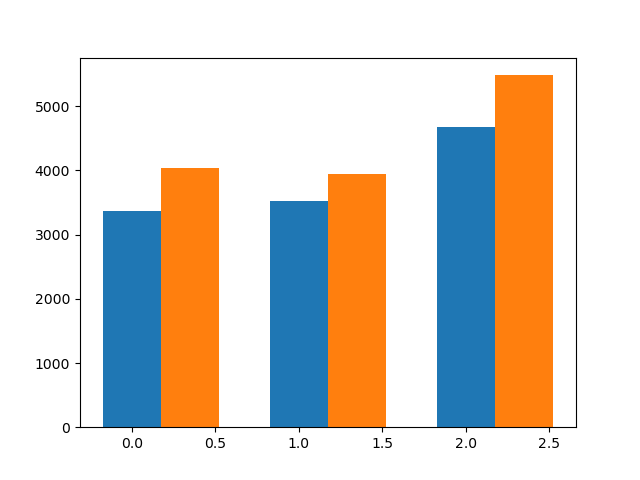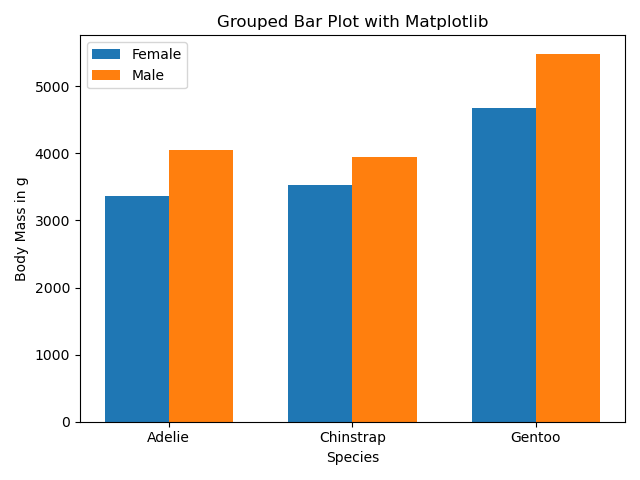In this tutorial, we will learn how to make grouped barplot using Matplotlib in Python. We will learn how to make a gropued barplot in a realize scenario, where the data is in a Pandas dataframe and we have do some data munging to get the data to make grouped barplot. Let us first load the packages needed.
1 2 | import matplotlib.pyplot as pltimport pandas as pd |
We will use Palmer penguins dataset to make the grouped barplots using Matplotlib in Python and we load the data using Seaborn’s built-in dataset.
1 2 3 4 5 6 7 8 9 10 | penguins = sns.load_dataset("penguins")penguins.head()species island bill_length_mm bill_depth_mm flipper_length_mm body_mass_g sex0 Adelie Torgersen 39.1 18.7 181.0 3750.0 Male1 Adelie Torgersen 39.5 17.4 186.0 3800.0 Female2 Adelie Torgersen 40.3 18.0 195.0 3250.0 Female3 Adelie Torgersen NaN NaN NaN NaN NaN4 Adelie Torgersen 36.7 19.3 193.0 3450.0 Female |
To get started let us calculate the data needed to make grouped barplot. In this example, we will make grouped barplot of penguin’s average body mass per species group by sex (male/female). Let us use Pandas’ groupby() function to the mean values of bodymass per species and sex.
1 2 3 4 5 6 7 8 9 10 11 12 13 14 15 | df = ( penguins.groupby(['species', 'sex'])["body_mass_g"] .mean() .reset_index())dfspecies sex body_mass_g0 Adelie Female 3368.8356161 Adelie Male 4043.4931512 Chinstrap Female 3527.2058823 Chinstrap Male 3938.9705884 Gentoo Female 4679.7413795 Gentoo Male 5484.836066 |
The data we have now is in long form. For making plots with Matplotlib, dataframe in wide form is very useful. Let us reshape the long form data to wide form data using Pandas’ pivot() function.
1 2 3 4 5 6 7 8 9 10 11 12 | df1 = (df .pivot(index="species", columns="sex") .reset_index() )#df1.columns = df1.columns.to_flat_index()df1.columns = ["_".join(a) for a in df1.columns.to_flat_index()]df1 species_ body_mass_g_Female body_mass_g_Male0 Adelie 3368.835616 4043.4931511 Chinstrap 3527.205882 3938.9705882 Gentoo 4679.741379 5484.836066 |
Now we have the data needed in the right shape. Let us go ahead and start making the grouped barplot. We will first specify the bar width and then use bar() function in Matplotlib at the correct x-axis location for each groups as shown below.
1 2 3 4 5 6 7 8 9 10 11 12 13 | # Define the width of the barsbar_width = 0.35x= range(df1.shape[0])# Plotting the grouped barsplt.bar(x, df1.body_mass_g_Female, width=bar_width, label='Female')plt.bar([i + bar_width for i in x], df1.body_mass_g_Male, width=bar_width, label='Male')plt.savefig("Grouped_barplot_barebone_Matplotlib_Python.png") |
We have the barebone grouped barplot ready now.

We can further customize the grouped barplot by adding labels, title and legend. We also customize the x-axis ticks using Matplotlib’s xticks() function.
1 2 3 4 5 6 7 8 9 10 11 12 13 14 15 16 17 18 19 20 | # Define the width of the barsbar_width = 0.35x= range(df1.shape[0])# Plotting the grouped barsplt.bar(x, df1.body_mass_g_Female, width=bar_width, label='Female')plt.bar([i + bar_width for i in x], df1.body_mass_g_Male, width=bar_width, label='Male')plt.savefig("Grouped_barplot_barebone_Matplotlib_Python.png")# Add labels, title, and legendplt.xlabel('Species')plt.ylabel('Body Mass in g')plt.title('Grouped Bar Plot with Matplotlib')plt.xticks([i + bar_width / 2 for i in x], df1.species_)plt.legend()plt.tight_layout() |
And now we have the grouped barplot that wanted.





